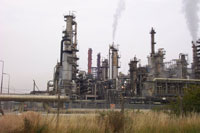Frequently asked questions
What is air pollution?

Air quality and the formulation and transport of air pollution is a highly complex subject that is dependent on many things including the weather, the natural environment, demographics and random and dynamic events, many of which cannot be predicted or forecast.
Air pollution is both naturally occurring (i.e. sulphurous gases from volcanos and smoke from forest fires) and man-made (vehicle exhaust and power station emissions).
Those people who were around in the 1940s and 1950s will remember the smog and “pea-soupers”, most notably the great London smog of 1952 which contributed to the death of up to 5000 people. Thankfully those days are gone (in the UK at least) and today’s air pollution is very different. Now, unlike the great smogs of the 1950s, air pollution is largely invisible and often without odour. The main pollutants in our towns and cities are oxides of nitrogen (NOx), respiratory particles (know as PM10), ozone (O3), volatile organic compounds (VOCs), sulphur dioxide (SO2) and carbon monoxide (CO). These pollutants are discussed elsewhere in the FAQs and in the links section. There are, of course, many more air-pollutants, especially near industrial plants such as chemical works, power stations etc.
Although we no longer suffer from the fatal smogs of the 1950s, air pollution still has many serious consequences that impact on the environment and human health - particularly the very young, the very old and those who suffer from asthma and other chronic respiratory illnesses. Air pollution has been linked to such illnesses and proven to exacerbate the degree of suffering.
Other air pollutants, such as benzene have been linked with different types of cancers in humans and animals.
Particulate matter, especially very fine particles (smaller than 10 microns – known as PM10), is thought to have a very large impact on human health and is one of the major problems facing environmental professionals. PM10 particles and even smaller fractions (PM2.5) can reach deep into our lungs and can cause severe respiratory problems as well as possibly contributing to many other conditions and diseases.
In towns and cities, the many individual pollutants can combine to form a "cocktail" which, under certain weather conditions (i.e. still, hot summer days), can lead to modern day smogs known as "photochemical smog". This is common in all large cities during this type of weather; some of the best-known "smog cities" include Los Angeles, Mexico City and, closer to home, even London.
